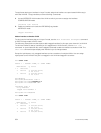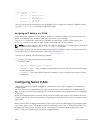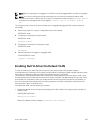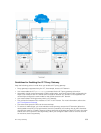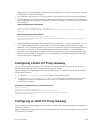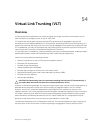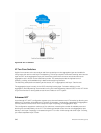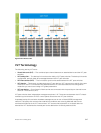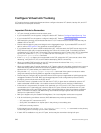• LLDP uses the existing infrastructure and adds a new TLV for sending and receiving on the configured
ports.
• There are only a few MAC addresses for each unit transmitted. All currently active MAC addresses are
carried on the newly defined TLV.
• Dell Networking devices not configured with VLT proxy gateway process standard TLVs and ignore
TLVs configured with VLT proxy gateway.
The LLDP organizational TLV passes local destination MAC address information to peer VLT domain
devices so they can act as a proxy gateway. To enable proxy gateway LLDP, two configurations are
required:
• You must configure the global proxy gateway LLDP to enable the proxy-gateway LLDP TLV.
• You must configure the interface proxy gateway LLDP to enable or disable a proxy-gateway LLDP TLV
on specific interfaces.
• The interface is typically a VLT port-channel that connects to a remote VLT domain.
• The new proxy gateway TLV is carried on the physical links under the port channel only.
• You must have at least one link connection to each unit of the VLT domain.
Following are the prerequisites for Proxy Gateway LLDP configuration:
• You must globally enable LLDP.
• You cannot have interface–level LLDP disable commands on the interfaces configured for proxy
gateway and you must enable both transmission and reception.
• You must connect both units of the remote VLT domain by the port channel member.
• If you connect more than one port to a unit of the remote VLT domain, the connection must be
completed by the time you enable the proxy gateway LLDP.
• You cannot have other conflicting configurations (for example, you cannot have a static proxy
gateway configuration).
Proxy Gateway LLDP configuration might not operate properly if one of the following conditions is true:
• Any proxy gateway configuration or LLDP configuration is not working.
• LLDP packets fail to reach the remote VLT domain devices (for example, because the system is down,
rebooting, or the port physical link connection is down).
VLT Proxy Gateway
941




